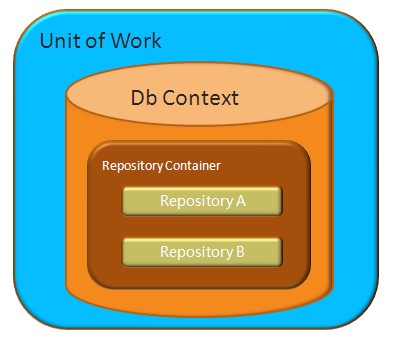Follow me to learn what is Unit of Work pattern
Introduction
A Unit of Work is a combination of several actions that will be grouped into a transaction. This means that all actions inside a unit of work are committed or rolled back. The advantage of using a unit of work is that multiple save actions to multiple repositories can be grouped as a unit.

The image above shows that the Unit of Work is the top-level component to be used. Each Unit Of Work contains its own DbContext instance.
Road Map
Part1:Follow me to learn how to use mvc template
Part2:Follow me to learn what is repository pattern
Part3:Follow me to learn what is Unit of Work pattern
How to implement Unit Of Work
Now, let us to start to implement unit of work
Step1: Create interface IUnitOfWork
public interface IUnitOfWork:IDisposable { bool IsCommitted { get; set; } int Commit(); void Rollback(); }
Step 2: Concrete Implementation of IUnitOfWork
public class UnitOfWorkBase : IUnitOfWork { public UnitOfWorkBase() { } private Dictionary<Type, object> _repositories; private ObjectContext _context=null; internal ObjectContext Context { get { return _context; } } public bool IsCommitted { get; set; } public RepositoryBase<TSet> GetRepository<TSet>() where TSet : class, new() { if (null == _repositories) _repositories = new Dictionary<Type, object>(); if (_repositories.Keys.Contains(typeof(TSet))) return _repositories[typeof(TSet)] as RepositoryBase<TSet>; var repository = new RepositoryBase<TSet>(true,this.Context); _repositories.Add(typeof(TSet), repository); if (null == _context) _context = repository.Repository.Context; return repository; } public int Commit() { if (IsCommitted) return 0; return this.Context.SaveChanges(); } public void Rollback() { this.IsCommitted = true; this.Context.Dispose(); } public void Dispose() { if (!this.IsCommitted) { this.Context.SaveChanges(); } this.Context.Dispose(); } }
Let’s take a look at our IRepository GetRepository<TSet>() method here in our UnitOfWork implementation. Here we are storing all the activated instances of repositories for each and every requests. One there is a request for a given repository we will first check to see if our Container has been created, if not, will go ahead and create our container. Next, we’ll scan our container to see if the requested repository instance has already been created, if it has, then will return it, if it hasn’t, we will activate the requested repository instance, store it in our container, and then return it. If it helps, you can think of this as lazy loading our repository instances, meaning we are only creating repository instances on demand, this allows us to only create the repository instances needed for a given web request.
How to use?

Demo
public ObjectModel.RoleAction DeleteAndInsertRoleAction(ObjectModel.RoleAction model, ObjectModel.TreeViewModel TreeView) { using (var dao = new UnitOfWorkBase()) { var repositoryNew = dao.GetRepository<RoleAction>(); var oldRecords = repositoryNew.Query(p => p.IsActive && p.RoleInfoId == model.RoleInfoId).ToList(); int roleid = model.RoleInfoId; List<string> newActionIds = TreeView.NodeItems.Where(item => item.Checked) .SelectMany(item => item.Items.Where(a => a.Checked)) .Select(a => a.Value) .ToList(); var deleteRecords = oldRecords.Where(p => !newActionIds.Contains(p.ActionInfoId.ToString())).ToList(); var insertRecords = newActionIds.Where(p => !oldRecords.Select(q => q.ActionInfoId.ToString()).Contains(p)).ToList(); try { foreach (var item in deleteRecords) { repositoryNew.Delete(item); } for (int i = 0; i < insertRecords.Count; i++) { RoleAction roleAction = new RoleAction(); roleAction.RoleInfoId = roleid; roleAction.ActionInfoId = Convert.ToInt32(insertRecords[i]); repositoryNew.Insert(roleAction); } } catch (Exception ex) { dao.Rollback(); throw ex; } } return model; }
Note:
refer to http://blog.catenalogic.com/post/2013/02/27/Entity-Framework-Unit-of-Work-and-repositories.aspx




 浙公网安备 33010602011771号
浙公网安备 33010602011771号